Critical Analysis of Racialization in Disney's The Little Mermaid
VerifiedAdded on 2022/08/21
|7
|1441
|20
Essay
AI Summary
This essay provides a critical analysis of the racialization present in Disney's The Little Mermaid, examining how the film reflects and perpetuates societal prejudices. The essay delves into the portrayal of gender discrimination, highlighting how the Little Mermaid is depicted as sacrificing her inherent personality to be with the prince. Furthermore, it analyzes the racial implications of the character's physical attributes, such as her 'white' skin tone and red hair, in the context of prevailing beauty standards and racism. The essay also examines the voice of the mermaid and the prince as it relates to gender roles. By deconstructing these elements, the essay argues that the movie reinforces ethnicism within the community. The conclusion emphasizes the importance of understanding how cultural products like movies reflect societal norms and prejudices. The essay references several academic sources to support its arguments.
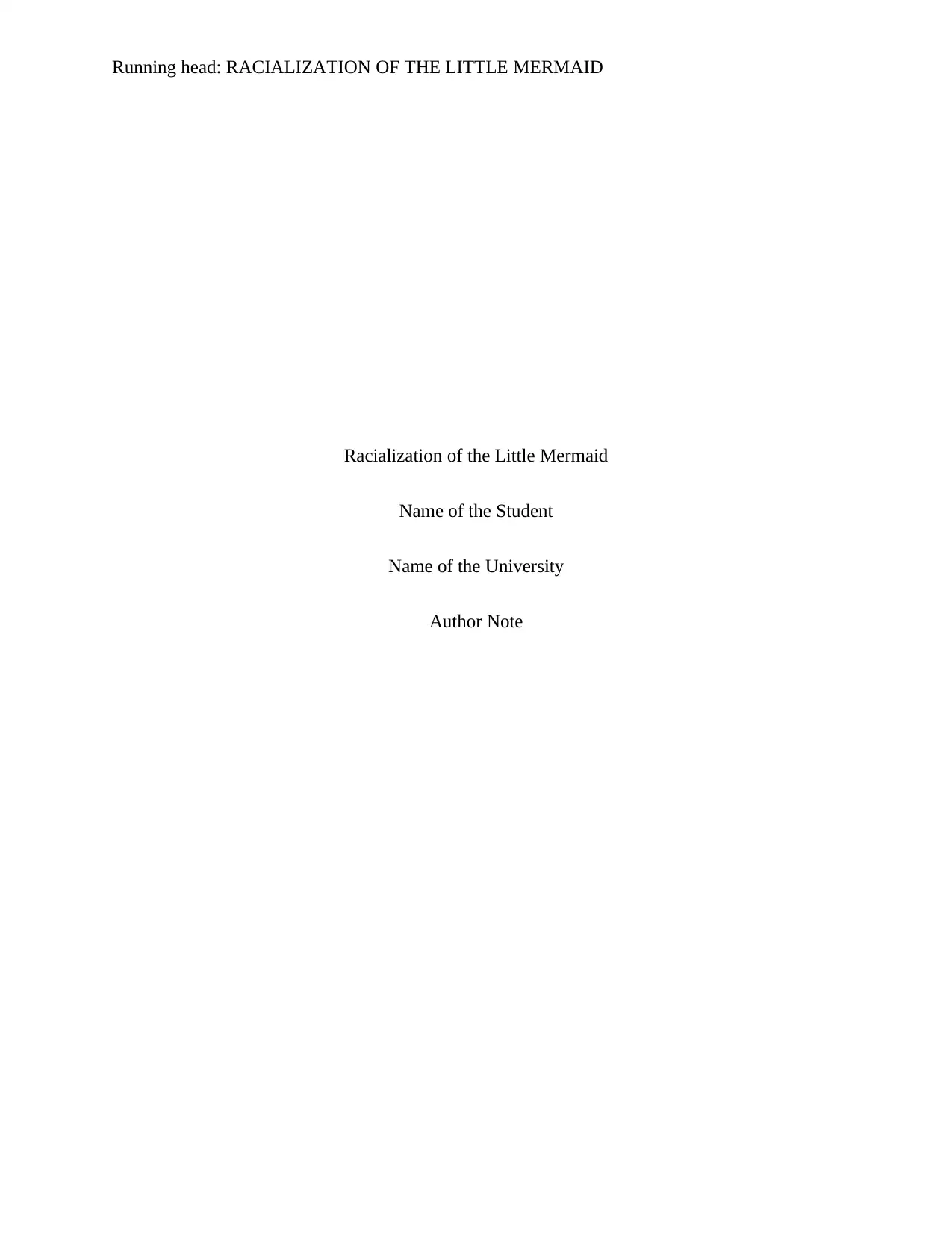
Running head: RACIALIZATION OF THE LITTLE MERMAID
Racialization of the Little Mermaid
Name of the Student
Name of the University
Author Note
Racialization of the Little Mermaid
Name of the Student
Name of the University
Author Note
Paraphrase This Document
Need a fresh take? Get an instant paraphrase of this document with our AI Paraphraser
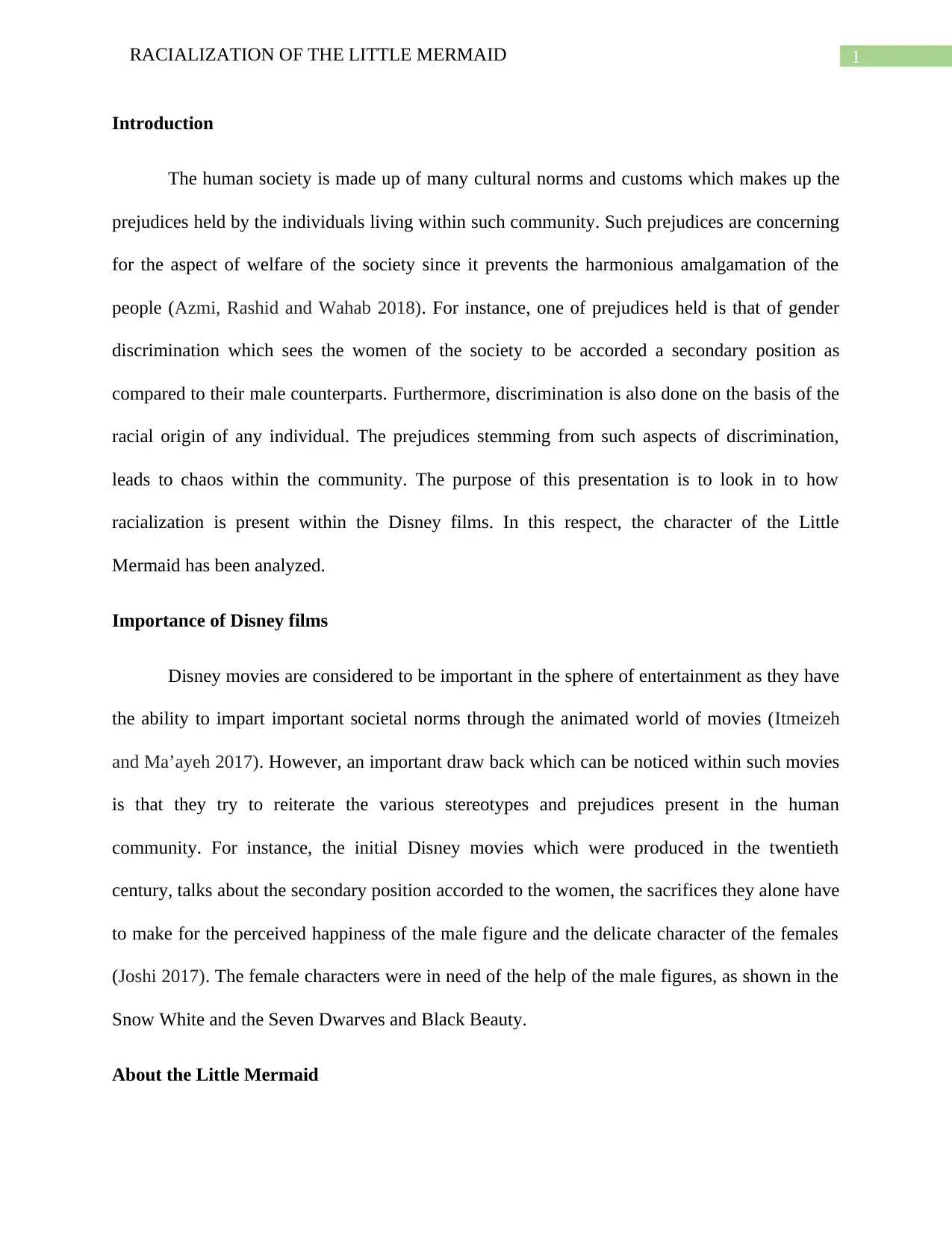
1RACIALIZATION OF THE LITTLE MERMAID
Introduction
The human society is made up of many cultural norms and customs which makes up the
prejudices held by the individuals living within such community. Such prejudices are concerning
for the aspect of welfare of the society since it prevents the harmonious amalgamation of the
people (Azmi, Rashid and Wahab 2018). For instance, one of prejudices held is that of gender
discrimination which sees the women of the society to be accorded a secondary position as
compared to their male counterparts. Furthermore, discrimination is also done on the basis of the
racial origin of any individual. The prejudices stemming from such aspects of discrimination,
leads to chaos within the community. The purpose of this presentation is to look in to how
racialization is present within the Disney films. In this respect, the character of the Little
Mermaid has been analyzed.
Importance of Disney films
Disney movies are considered to be important in the sphere of entertainment as they have
the ability to impart important societal norms through the animated world of movies (Itmeizeh
and Ma’ayeh 2017). However, an important draw back which can be noticed within such movies
is that they try to reiterate the various stereotypes and prejudices present in the human
community. For instance, the initial Disney movies which were produced in the twentieth
century, talks about the secondary position accorded to the women, the sacrifices they alone have
to make for the perceived happiness of the male figure and the delicate character of the females
(Joshi 2017). The female characters were in need of the help of the male figures, as shown in the
Snow White and the Seven Dwarves and Black Beauty.
About the Little Mermaid
Introduction
The human society is made up of many cultural norms and customs which makes up the
prejudices held by the individuals living within such community. Such prejudices are concerning
for the aspect of welfare of the society since it prevents the harmonious amalgamation of the
people (Azmi, Rashid and Wahab 2018). For instance, one of prejudices held is that of gender
discrimination which sees the women of the society to be accorded a secondary position as
compared to their male counterparts. Furthermore, discrimination is also done on the basis of the
racial origin of any individual. The prejudices stemming from such aspects of discrimination,
leads to chaos within the community. The purpose of this presentation is to look in to how
racialization is present within the Disney films. In this respect, the character of the Little
Mermaid has been analyzed.
Importance of Disney films
Disney movies are considered to be important in the sphere of entertainment as they have
the ability to impart important societal norms through the animated world of movies (Itmeizeh
and Ma’ayeh 2017). However, an important draw back which can be noticed within such movies
is that they try to reiterate the various stereotypes and prejudices present in the human
community. For instance, the initial Disney movies which were produced in the twentieth
century, talks about the secondary position accorded to the women, the sacrifices they alone have
to make for the perceived happiness of the male figure and the delicate character of the females
(Joshi 2017). The female characters were in need of the help of the male figures, as shown in the
Snow White and the Seven Dwarves and Black Beauty.
About the Little Mermaid
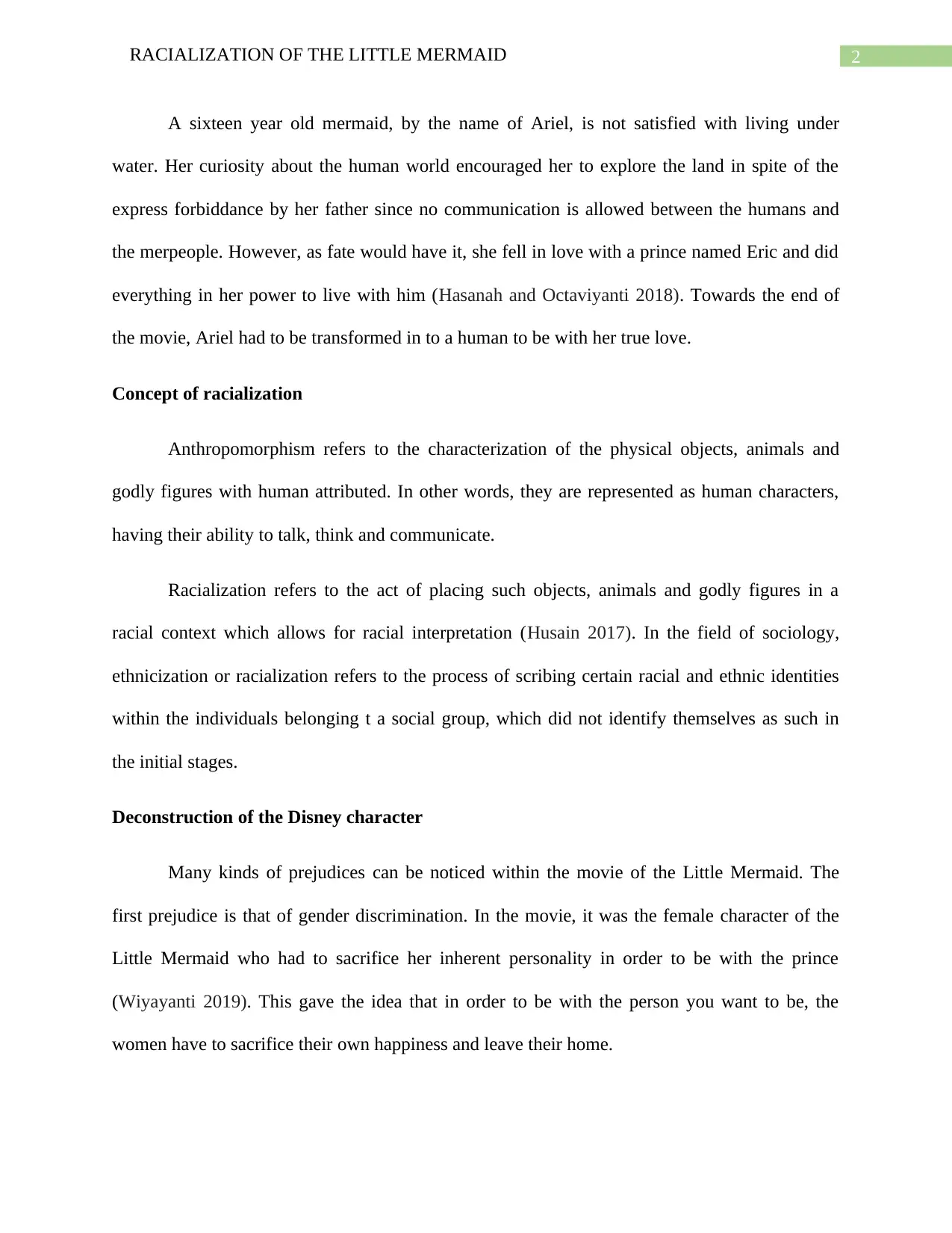
2RACIALIZATION OF THE LITTLE MERMAID
A sixteen year old mermaid, by the name of Ariel, is not satisfied with living under
water. Her curiosity about the human world encouraged her to explore the land in spite of the
express forbiddance by her father since no communication is allowed between the humans and
the merpeople. However, as fate would have it, she fell in love with a prince named Eric and did
everything in her power to live with him (Hasanah and Octaviyanti 2018). Towards the end of
the movie, Ariel had to be transformed in to a human to be with her true love.
Concept of racialization
Anthropomorphism refers to the characterization of the physical objects, animals and
godly figures with human attributed. In other words, they are represented as human characters,
having their ability to talk, think and communicate.
Racialization refers to the act of placing such objects, animals and godly figures in a
racial context which allows for racial interpretation (Husain 2017). In the field of sociology,
ethnicization or racialization refers to the process of scribing certain racial and ethnic identities
within the individuals belonging t a social group, which did not identify themselves as such in
the initial stages.
Deconstruction of the Disney character
Many kinds of prejudices can be noticed within the movie of the Little Mermaid. The
first prejudice is that of gender discrimination. In the movie, it was the female character of the
Little Mermaid who had to sacrifice her inherent personality in order to be with the prince
(Wiyayanti 2019). This gave the idea that in order to be with the person you want to be, the
women have to sacrifice their own happiness and leave their home.
A sixteen year old mermaid, by the name of Ariel, is not satisfied with living under
water. Her curiosity about the human world encouraged her to explore the land in spite of the
express forbiddance by her father since no communication is allowed between the humans and
the merpeople. However, as fate would have it, she fell in love with a prince named Eric and did
everything in her power to live with him (Hasanah and Octaviyanti 2018). Towards the end of
the movie, Ariel had to be transformed in to a human to be with her true love.
Concept of racialization
Anthropomorphism refers to the characterization of the physical objects, animals and
godly figures with human attributed. In other words, they are represented as human characters,
having their ability to talk, think and communicate.
Racialization refers to the act of placing such objects, animals and godly figures in a
racial context which allows for racial interpretation (Husain 2017). In the field of sociology,
ethnicization or racialization refers to the process of scribing certain racial and ethnic identities
within the individuals belonging t a social group, which did not identify themselves as such in
the initial stages.
Deconstruction of the Disney character
Many kinds of prejudices can be noticed within the movie of the Little Mermaid. The
first prejudice is that of gender discrimination. In the movie, it was the female character of the
Little Mermaid who had to sacrifice her inherent personality in order to be with the prince
(Wiyayanti 2019). This gave the idea that in order to be with the person you want to be, the
women have to sacrifice their own happiness and leave their home.
⊘ This is a preview!⊘
Do you want full access?
Subscribe today to unlock all pages.

Trusted by 1+ million students worldwide
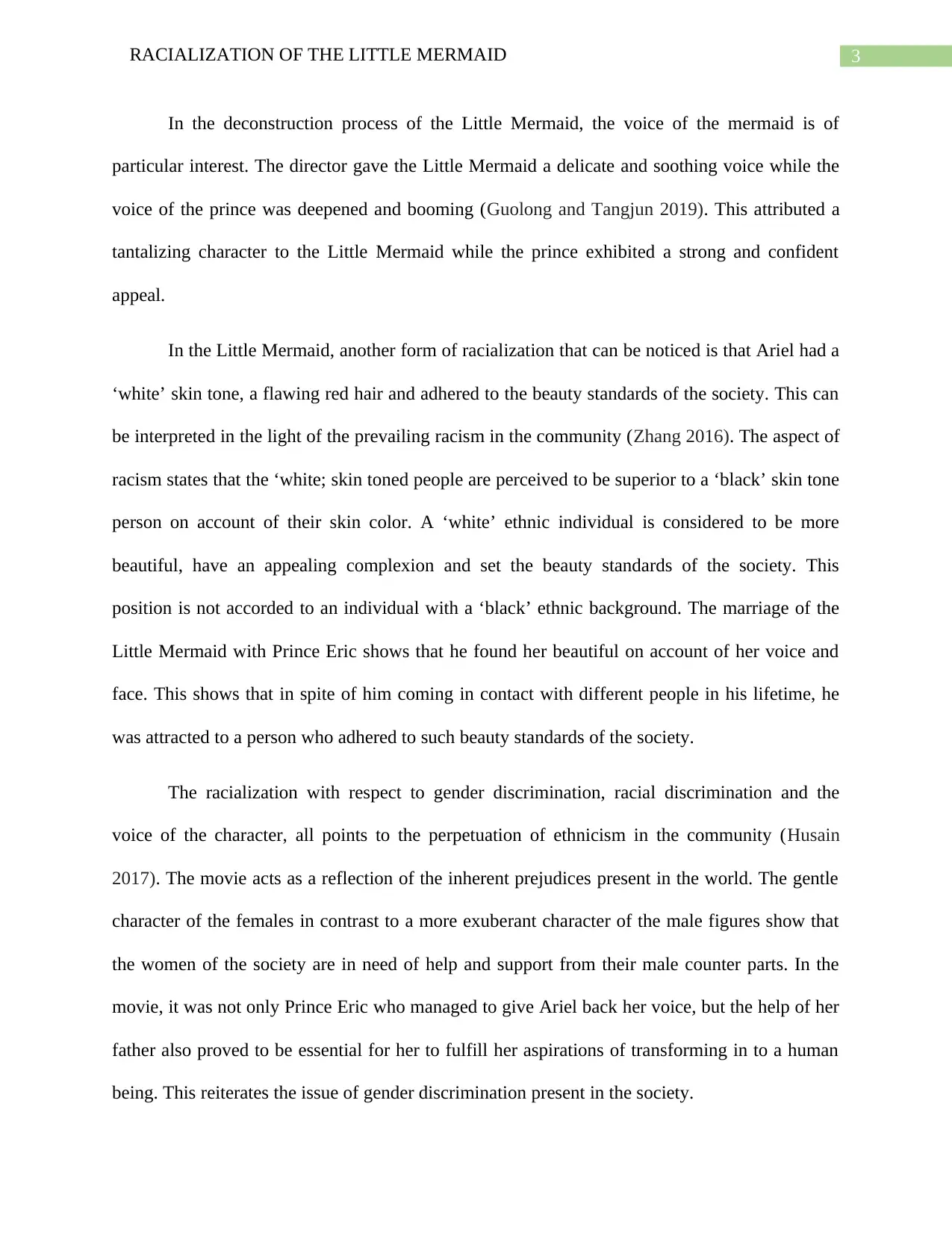
3RACIALIZATION OF THE LITTLE MERMAID
In the deconstruction process of the Little Mermaid, the voice of the mermaid is of
particular interest. The director gave the Little Mermaid a delicate and soothing voice while the
voice of the prince was deepened and booming (Guolong and Tangjun 2019). This attributed a
tantalizing character to the Little Mermaid while the prince exhibited a strong and confident
appeal.
In the Little Mermaid, another form of racialization that can be noticed is that Ariel had a
‘white’ skin tone, a flawing red hair and adhered to the beauty standards of the society. This can
be interpreted in the light of the prevailing racism in the community (Zhang 2016). The aspect of
racism states that the ‘white; skin toned people are perceived to be superior to a ‘black’ skin tone
person on account of their skin color. A ‘white’ ethnic individual is considered to be more
beautiful, have an appealing complexion and set the beauty standards of the society. This
position is not accorded to an individual with a ‘black’ ethnic background. The marriage of the
Little Mermaid with Prince Eric shows that he found her beautiful on account of her voice and
face. This shows that in spite of him coming in contact with different people in his lifetime, he
was attracted to a person who adhered to such beauty standards of the society.
The racialization with respect to gender discrimination, racial discrimination and the
voice of the character, all points to the perpetuation of ethnicism in the community (Husain
2017). The movie acts as a reflection of the inherent prejudices present in the world. The gentle
character of the females in contrast to a more exuberant character of the male figures show that
the women of the society are in need of help and support from their male counter parts. In the
movie, it was not only Prince Eric who managed to give Ariel back her voice, but the help of her
father also proved to be essential for her to fulfill her aspirations of transforming in to a human
being. This reiterates the issue of gender discrimination present in the society.
In the deconstruction process of the Little Mermaid, the voice of the mermaid is of
particular interest. The director gave the Little Mermaid a delicate and soothing voice while the
voice of the prince was deepened and booming (Guolong and Tangjun 2019). This attributed a
tantalizing character to the Little Mermaid while the prince exhibited a strong and confident
appeal.
In the Little Mermaid, another form of racialization that can be noticed is that Ariel had a
‘white’ skin tone, a flawing red hair and adhered to the beauty standards of the society. This can
be interpreted in the light of the prevailing racism in the community (Zhang 2016). The aspect of
racism states that the ‘white; skin toned people are perceived to be superior to a ‘black’ skin tone
person on account of their skin color. A ‘white’ ethnic individual is considered to be more
beautiful, have an appealing complexion and set the beauty standards of the society. This
position is not accorded to an individual with a ‘black’ ethnic background. The marriage of the
Little Mermaid with Prince Eric shows that he found her beautiful on account of her voice and
face. This shows that in spite of him coming in contact with different people in his lifetime, he
was attracted to a person who adhered to such beauty standards of the society.
The racialization with respect to gender discrimination, racial discrimination and the
voice of the character, all points to the perpetuation of ethnicism in the community (Husain
2017). The movie acts as a reflection of the inherent prejudices present in the world. The gentle
character of the females in contrast to a more exuberant character of the male figures show that
the women of the society are in need of help and support from their male counter parts. In the
movie, it was not only Prince Eric who managed to give Ariel back her voice, but the help of her
father also proved to be essential for her to fulfill her aspirations of transforming in to a human
being. This reiterates the issue of gender discrimination present in the society.
Paraphrase This Document
Need a fresh take? Get an instant paraphrase of this document with our AI Paraphraser
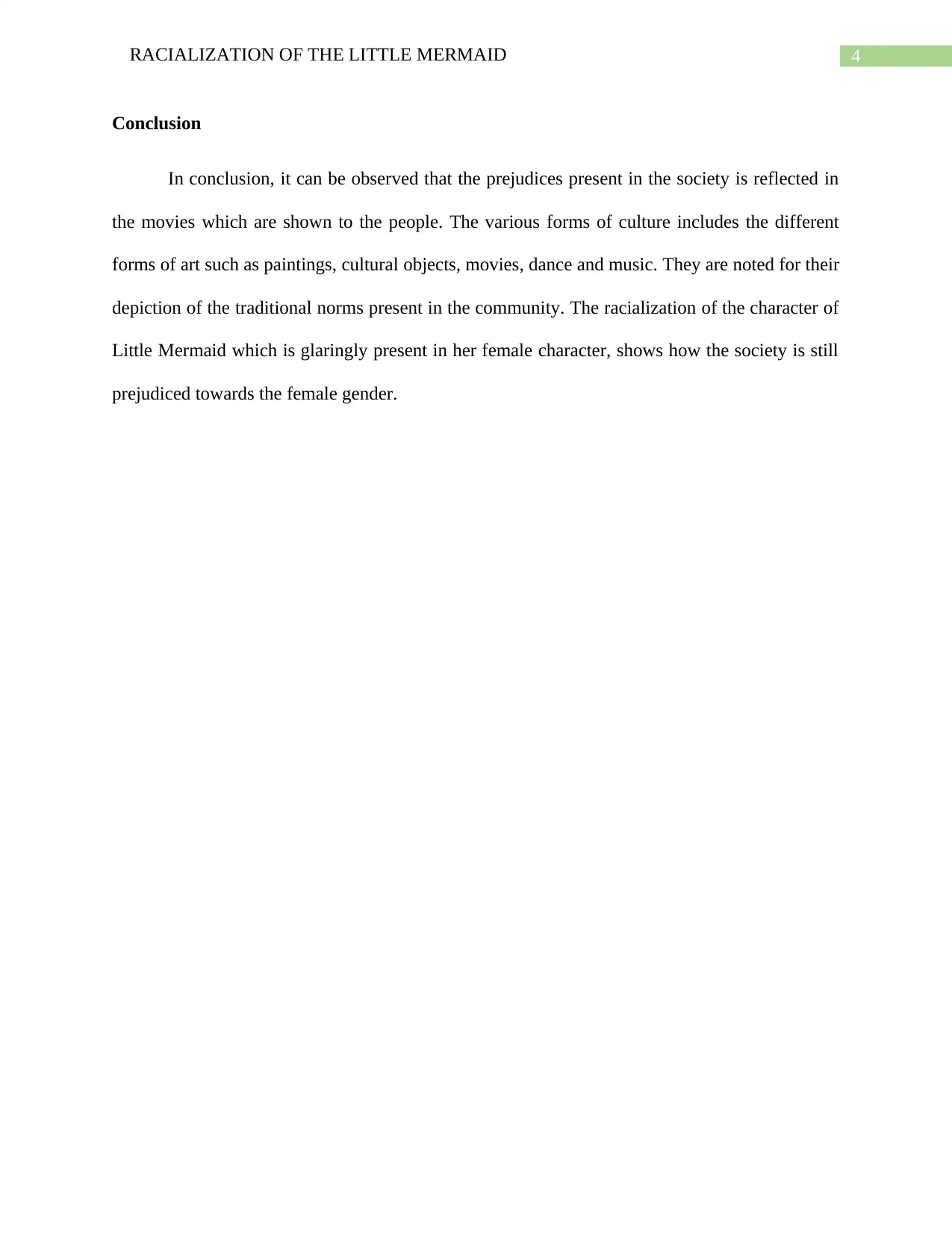
4RACIALIZATION OF THE LITTLE MERMAID
Conclusion
In conclusion, it can be observed that the prejudices present in the society is reflected in
the movies which are shown to the people. The various forms of culture includes the different
forms of art such as paintings, cultural objects, movies, dance and music. They are noted for their
depiction of the traditional norms present in the community. The racialization of the character of
Little Mermaid which is glaringly present in her female character, shows how the society is still
prejudiced towards the female gender.
Conclusion
In conclusion, it can be observed that the prejudices present in the society is reflected in
the movies which are shown to the people. The various forms of culture includes the different
forms of art such as paintings, cultural objects, movies, dance and music. They are noted for their
depiction of the traditional norms present in the community. The racialization of the character of
Little Mermaid which is glaringly present in her female character, shows how the society is still
prejudiced towards the female gender.
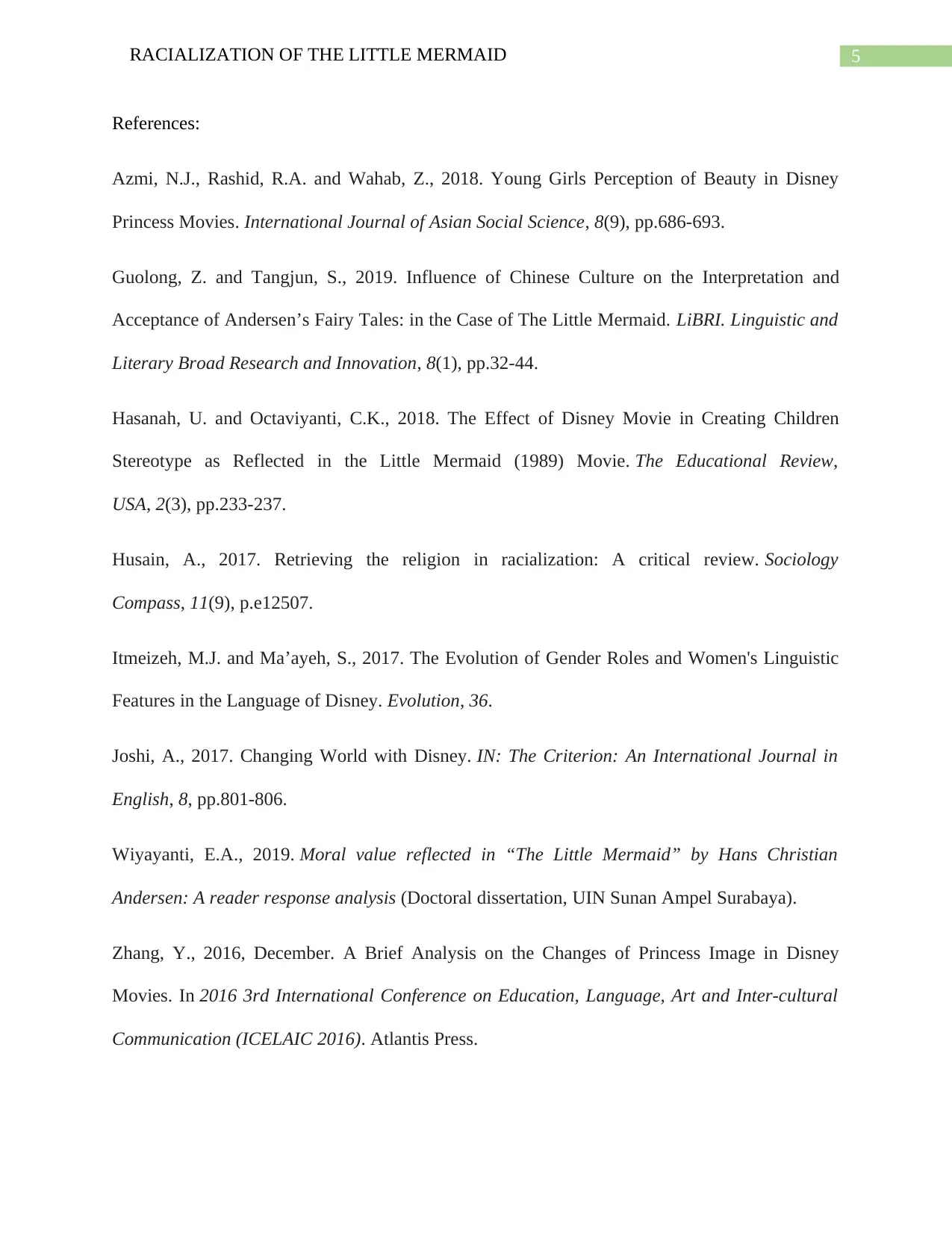
5RACIALIZATION OF THE LITTLE MERMAID
References:
Azmi, N.J., Rashid, R.A. and Wahab, Z., 2018. Young Girls Perception of Beauty in Disney
Princess Movies. International Journal of Asian Social Science, 8(9), pp.686-693.
Guolong, Z. and Tangjun, S., 2019. Influence of Chinese Culture on the Interpretation and
Acceptance of Andersen’s Fairy Tales: in the Case of The Little Mermaid. LiBRI. Linguistic and
Literary Broad Research and Innovation, 8(1), pp.32-44.
Hasanah, U. and Octaviyanti, C.K., 2018. The Effect of Disney Movie in Creating Children
Stereotype as Reflected in the Little Mermaid (1989) Movie. The Educational Review,
USA, 2(3), pp.233-237.
Husain, A., 2017. Retrieving the religion in racialization: A critical review. Sociology
Compass, 11(9), p.e12507.
Itmeizeh, M.J. and Ma’ayeh, S., 2017. The Evolution of Gender Roles and Women's Linguistic
Features in the Language of Disney. Evolution, 36.
Joshi, A., 2017. Changing World with Disney. IN: The Criterion: An International Journal in
English, 8, pp.801-806.
Wiyayanti, E.A., 2019. Moral value reflected in “The Little Mermaid” by Hans Christian
Andersen: A reader response analysis (Doctoral dissertation, UIN Sunan Ampel Surabaya).
Zhang, Y., 2016, December. A Brief Analysis on the Changes of Princess Image in Disney
Movies. In 2016 3rd International Conference on Education, Language, Art and Inter-cultural
Communication (ICELAIC 2016). Atlantis Press.
References:
Azmi, N.J., Rashid, R.A. and Wahab, Z., 2018. Young Girls Perception of Beauty in Disney
Princess Movies. International Journal of Asian Social Science, 8(9), pp.686-693.
Guolong, Z. and Tangjun, S., 2019. Influence of Chinese Culture on the Interpretation and
Acceptance of Andersen’s Fairy Tales: in the Case of The Little Mermaid. LiBRI. Linguistic and
Literary Broad Research and Innovation, 8(1), pp.32-44.
Hasanah, U. and Octaviyanti, C.K., 2018. The Effect of Disney Movie in Creating Children
Stereotype as Reflected in the Little Mermaid (1989) Movie. The Educational Review,
USA, 2(3), pp.233-237.
Husain, A., 2017. Retrieving the religion in racialization: A critical review. Sociology
Compass, 11(9), p.e12507.
Itmeizeh, M.J. and Ma’ayeh, S., 2017. The Evolution of Gender Roles and Women's Linguistic
Features in the Language of Disney. Evolution, 36.
Joshi, A., 2017. Changing World with Disney. IN: The Criterion: An International Journal in
English, 8, pp.801-806.
Wiyayanti, E.A., 2019. Moral value reflected in “The Little Mermaid” by Hans Christian
Andersen: A reader response analysis (Doctoral dissertation, UIN Sunan Ampel Surabaya).
Zhang, Y., 2016, December. A Brief Analysis on the Changes of Princess Image in Disney
Movies. In 2016 3rd International Conference on Education, Language, Art and Inter-cultural
Communication (ICELAIC 2016). Atlantis Press.
⊘ This is a preview!⊘
Do you want full access?
Subscribe today to unlock all pages.

Trusted by 1+ million students worldwide

6RACIALIZATION OF THE LITTLE MERMAID
1 out of 7
Your All-in-One AI-Powered Toolkit for Academic Success.
+13062052269
info@desklib.com
Available 24*7 on WhatsApp / Email
![[object Object]](/_next/static/media/star-bottom.7253800d.svg)
Unlock your academic potential
Copyright © 2020–2025 A2Z Services. All Rights Reserved. Developed and managed by ZUCOL.


